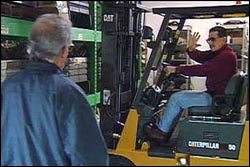Powered Industrial Trucks (Forklift) eTool
Understanding the Workplace » Pedestrian Traffic

Many pedestrians or bystanders are injured in forklift-related accidents. These injuries can occur when forklifts strike pedestrians or when pedestrians are struck by falling loads.
Additional Resources:
- NIOSH Alert: Preventing Injuries and Deaths of Workers Who Operate or Work Near Forklifts. DHHS (NIOSH) Publication No. 2001-109, (2001, June). Forklift overturns are the leading cause of fatalities involving forklifts; they represent about 25 percent of all forklift-related deaths.


Forklift operators should always be aware of conditions in their workplace, including pedestrian traffic. Forklift traffic should be separated from other workers and pedestrians where possible.
Potential Hazard
-
Danger of striking pedestrians and objects
Requirements and Recommended Practices
-
Yield right of way to pedestrians.
-
When a person or group of people walks across your planned route:
-
Stop.
-
Wait until the pedestrians pass by.
-
Proceed cautiously through any congested area.
-
-
If an area is cluttered, walk the route first to spot problems.
-
Check for situations that require a spotter and use one when traveling.
-
Warn pedestrians, by asking them to move, if there is not sufficient safe clearance.
-
Sound the horn at blind corners, doorways and aisles.
-
Sound the horn or other alarm when you back up.
-

Reminders for the Driver
-
Slow down, stop and sound horn at intersections, corners, and wherever your vision is obstructed.
-
When provided, use flashing warning light or backup alarms when traveling in reverse.
-
Do not move the truck if you do not have a clear view of travel.
-
Use a spotter for blind spots.
-
Always look in the direction of travel.
-
Keep a clear view.
-
Start, stop, travel, steer and brake smoothly.
-
Signal to pedestrians to stand clear.
-
Do not allow anyone to stand or pass under the load or lifting mechanism.
-
When possible, make eye contact with pedestrians or other forklift operators.
Reminders for the Pedestrians
-
Be aware that lift trucks cannot stop suddenly. They are designed to stop slowly to minimize load damage and maintain stability.
-
Stand clear of lift trucks in operation.
-
Avoid a run-in. The driver's visibility may be limited due to blind spots.
-
Be aware of the wide rear swing radius.
-
Use pedestrian walkways, or stay to one side of the equipment aisle.
-
Never ride on a forklift, unless authorized and the forklift is designed for riders.
-
Never pass under an elevated load.
Reminders for Plant Safety Managers
-
OSHA requires that permanent aisles and passageways be free from obstructions and appropriately marked where mechanical handling equipment is used. [29 CFR 1910.176(a)]
-
Consider separating pedestrians from lift trucks by providing:
-
Pedestrian walkways,
-
Permanent railings or other protective barriers,
-
Adequate walking space at least on one side, if pedestrians must use equipment aisles,
-
Pedestrian walkway striping on the floor, if barriers cannot be used.
-
-
Install convex mirrors at blind aisle intersections.
-
Post traffic control signs.
-
Post plant speed limits.


Passengers should not be allowed on forklifts unless the forklift is specifically designed to accommodate passengers.
Potential Hazard
-
Danger of falling
Requirements and Recommended Practices
-
The OSHA standard [29 CFR 1910.178(m)(3)] states that unauthorized personnel are prohibited from riding on a forklift. If riders are authorized, a safe place must be provided.
-
Unless authorized, never carry passengers --
NO RIDERS. -
Use only specialized equipment designed to raise personnel.
-
Never transport employees on a platform. Employees can only be hoisted up and down.
-
Never transport employees on the forks.

Forklift operators should keep a safe distance from workers on foot and other pedestrians.
Potential Hazard
-
Danger of striking pedestrians
Requirements and Recommended Practices
-
Warn pedestrians of your approach by horn, hand signal, or warning light.
-
Maintain a safe clearance from coworkers.
-
Employees should stay out of the potential path where a load can fall.

